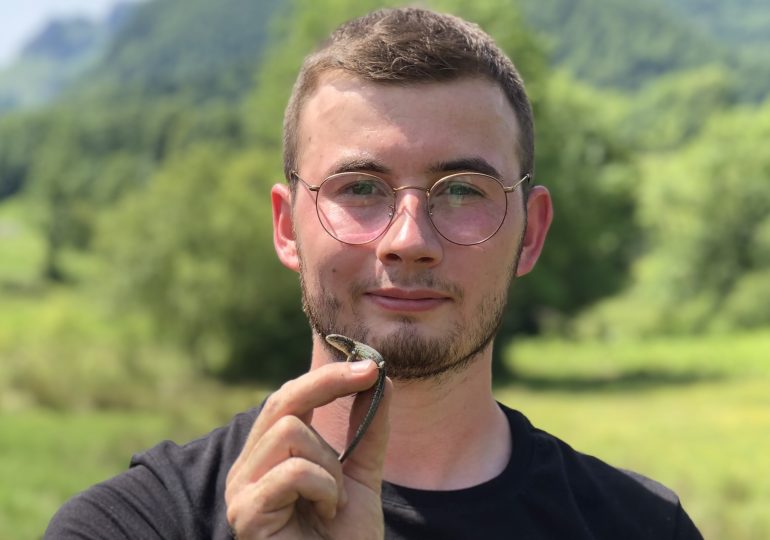In this week’s blog post, we’re checking our calendars and addressing how climate change is causing shifts in breeding dates for reptiles! Discussing the article “A multi-trait evaluation of patterns and fitness consequences of breeding phenology plasticity with nocturnal warming and food restriction in a lizard”, Théo Bodineau explains just how sensitive the natural world can be to thermal changes from climate change and how nocturnal warming can determine breeding behaviours and gestation periods of female lizards. Now a postdoc, Théo shares why it’s so important to give yourself the grace in finding your career path.
About the Paper
Climate change is causing shifts in the breeding dates of many species, particularly animals that are highly dependent on external heat sources such as ectotherms (e.g., insects, amphibians, reptiles, etc.). These changes are largely due to the acceleration of embryonic development in warmer environments, which shortens the incubation or gestation period, leading to earlier hatching or birth dates. While earlier hatching/birth dates are often advantageous for offspring, the acceleration of gestation induced by warming can have negative consequences for females, especially in viviparous species where embryonic development occurs in utero and gestation represents an energy-costly critical life stage. The consequences of accelerated gestation may be exacerbated, particularly when food resources are limited or when behavioural compensations to avoid heat (e.g., selection of cooler microhabitats, adjustments in thermoregulatory behaviours) are reduced.
In this context, we studied how nocturnal warming and prey availability during gestation affected the condition of females, their reproductive output, and the fate of both females and their offspring in the common lizard (Zootoca vivipara). Our results show that food restriction and the acceleration of gestation due to high nocturnal temperatures had negative consequences for females, causing physiological imbalances (e.g., decreased energy condition, reduced immune response) and a decline in reproductive investment (resources put into producing offspring). In contrast, thermal acceleration of gestation induced by nocturnal warming had positive effects on offspring by increasing their endurance at birth and promoting growth during the first few months of life. Overall, our results indicate negative effects of both constraints (nocturnal warming and food restriction) on pregnant females, rather than an amplification of the nocturnal warming effects due to the limited prey availability in the environment. Females also displayed insufficient behavioural strategies to mitigate the effects of these constraints. Our results highlight the importance of considering nocturnal warming and prey availability as factors that cause increased physiological imbalances and negative effects on the reproduction of ectotherms. They also emphasize the need to consider both the benefits and costs of earlier breeding dates for females and their offspring in order to enhance our understanding of the impacts of climate change.
About the Research
This experimental work was carried out at the CEREEP-Ecotron IleDeFrance field station, a research center located 1 hour away from Paris with infrastructures dedicated to experimental ecology. The lizards used in this experiment come from populations maintained year-round in terrestrial macrocosms placed in a wet meadow favourable to the common lizard.
Outdoor macrocosms in which populations of common lizards are maintained at the CEREEP-Ecotron IleDeFrance, France. All populations are monitored annually by Jean-François Le Galliard, Sandrine Meylan (pictured here), Beatriz Decencière and Simon Agostini (Credit: Jean-François Le Galliard).
Reproductive females were captured at the beginning of May (after mating season) and maintained in the laboratory in individual terrariums. We then exposed the females to contrasting food availability and nocturnal temperatures using separate breeding rooms throughout the gestation period. We monitored their physiological condition (energy status, immunity, glucocorticoids, oxidative stress) at the beginning, middle, and end of gestation by precisely determining the stage of pregnancy using ultrasound imaging. This tool, recently introduced to our team, provides an exceptional non-invasive method for tracking reproductive status, gestation progress, as well as embryonic growth and physiology.
We also monitored the females’ behaviours (body temperature, activity, food consumption) to see how they were able to respond to the constraints, and then quantified reproductive investment as well as the quality of reproduction and the juveniles produced (eg. body condition, endurance). Females and juveniles were then released back into terrestrial macrocosms and recaptured at the end of the summer to estimate their survival, growth, and body condition. The challenge of this study was primarily in the diversity of the phenotypic and reproductive traits measured throughout the breeding season, as well as the management of breeding and births. Beyond the females in this experiment, we monitor all individuals in the semi-captive populations, with approximately 2500 juveniles born in captivity each year! Additionally, monitoring these animals requires a significant investment. The harsh winter and spring weather conditions also favoured the emergence of fungal diseases, on an unprecedented scale, which required veterinary expertise and individual care several times a week.
About the author
My interest in ecology began during medical school, when I was interested in physiology and attended a course in evolutionary biology. I quickly realised that I didn’t want to become a medical doctor and decided to shift my focus by joining a “Life Sciences and Organism Biology” Bachelor’s program, where I discovered ecophysiology. After completing a Master’s in Ecophysiology, Ecology, and Ethology, I decided to undertake a PhD to explore the causes and consequences of phenological changes in reptiles using an integrative approach combining ecophysiology, quantitative genetics, and evolutionary ecology. I was fortunate to join a dynamic team, which allowed me to carry out both experimental studies (like the one presented in this article) and correlational studies in the Massif Central mountain range in France. I am now a postdoctoral researcher at the Centre de Recherche sur la Biodiversité et l’Environnement (CRBE, Toulouse – France), where I investigate geographic variation in life-history traits and the consequences of climate change–induced acceleration of the pace of life in reptiles. I also aim to understand their plastic and adaptive responses to these environmental changes.
Leave a comment





